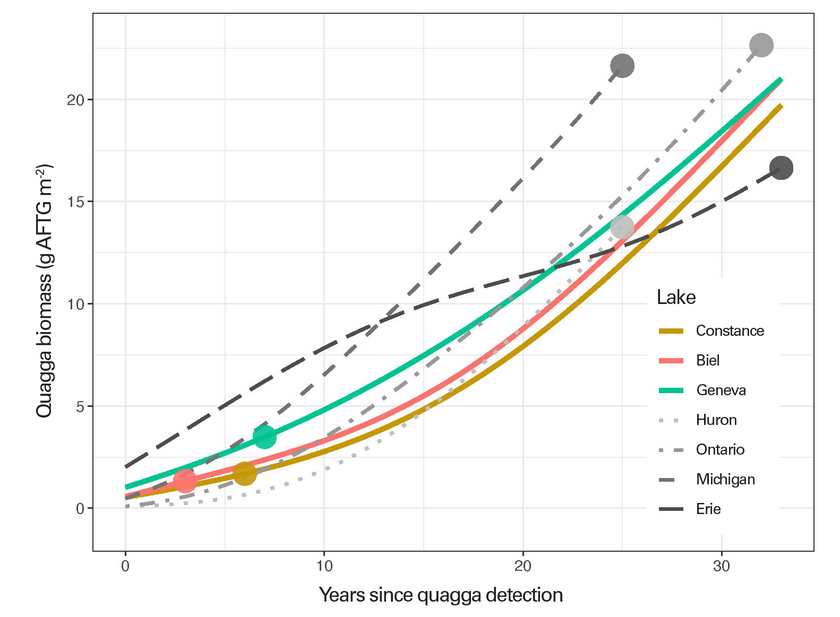News Detail
Quagga mussel: prognosis for affected lakes
November 16, 2023 |
The invasive quagga mussel has already gained a foothold in numerous bodies of water in Switzerland. For three affected Swiss lakes, a prediction of the extent to which the quagga mussel will continue to spread has now been made for the first time as part of the SeeWandel project, as a collaboration between researchers from the aquatic research institute Eawag, the universities of Geneva and Constance and others. According to this publication, the biomass per square metre in Lake Constance, Lake Geneva and Lake Biel is likely to increase by a factor of nine to 20 over the next 22 years, and the quagga mussel is likely to shift into the deeper parts of the lakes. The researchers expect comparable dynamics in the deep lakes of the Alpine forelands to that which has been observed in the Great Lakes of North America, where the quagga mussel was introduced more than 20 years earlier than in Europe. In both regions, the quagga mussel causes problems for water intakes and for heating/cooling installations because it clogs pipes, causing millions of dollars in damage. Furthermore, quagga mussels have changed the nutrient dynamics in the Great Lakes. Phosphorus cycling in the invaded Great Lakes is now regulated by the population dynamics of a single benthic species, the quagga mussel.
In lakes that are already affected, the dynamics can no longer be stopped due to the invasiveness of the mussels. “Unfortunately, this is bad news for the deep lakes of the Alpine foreland that are affected by quagga mussels,” says biologist Piet Spaak, Swiss quagga mussel specialist and group leader at Eawag, and last author on the publication. According to Spaak, however, the consequences can still be mitigated, for example by designing the infrastructure in such a way that the mussels and their larvae cannot enter. “At the same time, this is a warning for lakes in which the quagga mussel has not yet been found, such as Lake Zurich and Lake Lucerne. With appropriate measures, for example mandatory boat cleaning and targeted information campaigns, the spread into new waters can still be prevented.”
A look across the Atlantic and a glimpse into the future
While the quagga mussel was only detected in Switzerland in 2014, it has been spreading in North American lakes since the late 1980s. In their latest publication, the researchers led by first author Benjamin Kraemer from the University of Konstanz therefore compared data on the beginning of the spread from four of the five North American Great Lakes (Huron, Ontario, Michigan and Erie) with data from three Swiss lakes. As a matter of fact, the dispersal patterns largely match. “We therefore assume that the spread of the quagga mussel in Europe will take place just as fast,” says Kraemer. As in North America, this increase will probably be characterised by a trend towards larger individuals, and thus higher biomass per area, and a shift to greater depths. Kraemer says that “quagga mussels will increase water clarity and sequester nutrients and carbon through the construction of their shells.” There are still many unknowns, and the “ultimate impact of quaggas will depend on how they interact with climate change and other future environmental changes.”
Possible consequences for water bodies that will be affected by quagga mussels include:
- Decrease in plankton, as quagga mussels filter out large amounts of phytoplankton
- Increase in visibility due to the decline in plankton
- Changes in species communities and the food web
- Changes in fish stocks
- Increased maintenance and costs for water infrastructure
- More mussel shells in the shore area
Monitoring for more accurate data
Spaak stresses that the comparison should be repeated about every five years to keep an ongoing record of the dynamics. For the other Swiss lakes, too, Eawag will continue to promote the monitoring of the quagga mussel in cooperation with the federal government and the cantons over the next few years. New methods, for example using environmental DNA, will support the researchers in this endeavour. The objective is to detect new colonisations in previously unaffected lakes as early as possible and to investigate distribution patterns and population dynamics even more accurately.

A look back: why the quagga mussel has been so successful
Quagga mussels (Dreissena rostriformis) have been spreading in Swiss bodies of water for almost ten years . Originally from the Black Sea region, it is now widespread in large parts of Europe and North America.
Since it was first found in Switzerland in 2014 in the River Rhine near Basel, the quagga mussel has been spreading rapidly in Switzerland, as Piet Spaak and a team from Eawag, the University of Konstanz and various cantons and countries were able to verify in 2022. So far, it has been found in Lake Geneva, Lake Constance, Lake Neuchatel, Lake Biel, Lac de l’Hongrin and Lake Murten.
In contrast to the shallow water zones of the mussel’s native habitat, in the deep lakes of the Alpine foreland it is only eaten in relatively small numbers by water birds and fish. This, together with its excellent ability to disperse, reproduce and occupy a wide ecological niche, make it a successful invader, especially in deep lakes in Switzerland, Germany, Austria, France and Italy.
Cover picture: Quagga mussels in Lake Geneva: the biomass per square metre is likely to increase by a factor of nine to 20 over the next 22 years. (Photo: Eawag, Linda Haltiner)
Original publication
Kraemer, B. M., et al. (2023) An abundant future for quagga mussels in deep European lakes, Environmental Research Letters, https://doi.org/10.1088/1748-9326/ad059f
Funding / Partnerships
- Eawag
- SeeWandel project
- University of Konstanz
- University of Geneva
- SUNY Buffalo State University, USA
- University of Kansas, USA
- University of Maryland, USA



